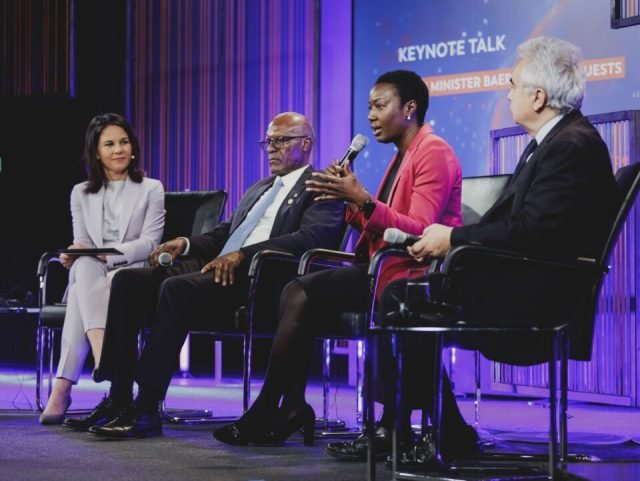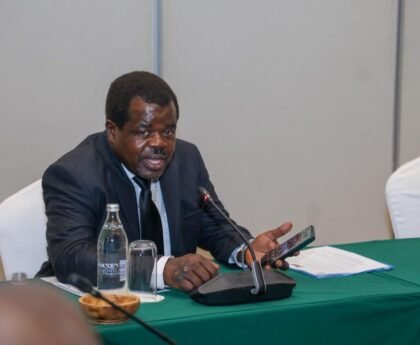Was this a pragmatic dialogue? This is the question that lingers in conversations with most scholars, pundits and critics in the energy sector as the 10th Berlin Energy Transition Dialogue (BETD) comes to a close.
During the ongoing dialogue, a look into the International Renewable Energy Agency (IRENA)… “The Volume 2 of the World Energy Transitions Outlook 2023 contends that current transition narratives may not resonate with all stakeholders, largely due to their omission of central socio-economic dimensions. Bridging gaps in climate policy ambition and fostering essential structural changes necessitates unparallel global collaboration.”
To understand more on this, I speak to the Director General International Renewable Energy Agency (IRENA) Francesco La Camera who opines that “If we want to be in line with what we need in limiting global temperature to within 1.5° of pre-industrial levels we have to install 1100 GW per year which means more than double what we have done in the last one year.
We have to abandon this concept of neutral technology…technology neutrality…carbon neutrality doesn’t exist…and have to understand that every system needs structures that sustain the system itself”

A report from the International Renewable Energy Agency (IRENA) avers “An average of almost 1,100 GW of renewables capacity must be installed annually by 2030 – more than double the record set in 2023. Annual investments in renewable power generation must surge from USD 570 billion in 2023 to USD 1550 billion on average between 2024 and 2030.”
This then gives a clear picture of what needs to be implemented in order to bridge structural disparities and quell what emerging puzzles and worries from countries that feel this is not a one size fit all solution in matters energy for all countries.
Auma Obama a distinguished scholar, who attended the 2-day conference in Berlin expresses her concerns.

“It worries me because I feel the conversation is being heard at a level that the African continent cannot actually participate in the dialogue and this is a worry because decisions are going to be made, people will come up with treaties and contracts of how to do things that does not take the African continent into account.” ~Auma Obama
This makes achieving the global target set at COP28 to triple renewable power capacity by 2030 look like a mirage or a distant dream even though seen as feasible with the right policy support and investments.
I later have a sit down with the indomitable Ndiarka Mbodji, the Managing Director, Kowry Energy Services that enables access to clean energy in Sub-Saharan Africa. Ndiarka, a seasoned leader with over 23 years across automotive and aerospace and power systems is not shy to point out the glaring gaps in renewable energy especially in Africa, key among them being financing and capacity building.

When we think of Africa we think of Solar energy, but Ndiarka highlights others which include wind power and geothermal energy especially in Kenya that needs funding and if fully explored can be used to power the whole country and its surrounding neighbors. Key to note is that in Namibia they are putting up a hydrogen plant which is the next frontier and needs investment.
“What we normally underestimate in Africa is that 70 % of people work in agriculture, it still an agriculture dominated landscape the biogas is not well exploited yet I think we need to do more around biomass and of course in countries such as Senegal, Mozambique and the Gambia. If there is gas and oil in some of these African countries, they would like to leverage on that gas so as to industrialize their countries so we have a mix on renewable energy.” ~Ndiarka Mbodji
It is estimated that in Sub Saharan Africa which is basically 49 countries minus the Maghrib and South Africa with 1.2 billion people ,600 million are without access to power at all.
“To give perspective 49 countries store capacity on the power plant installed is around 100-120 gigawatts, this is half the capacity of France so France has 64 million people, sub–Saharan Africa is 1.2 billion people and the gigawatt is 220, when we talk about this transition in energy it is important to keep that in mind of what are transitioning from?” Ndiarka Mbodji questions.
The power in most major cities in Africa is not reliable, which impacts immensely on the small and medium-sized enterprises. According to Ndiarka, the financing coming into Africa is a drop in the ocean compared to the total Energy finance as 99.99% is in developed countries.
“The main issue there is perceived risk when you come into Africa…don’t get me wrong it’s absolutely challenging…but I insist on the perceived risk because we use financing instruments which were developed after the second world war to rebuild Europe and also to stabilize the west and we use that to apply the same financial instruments into emerging and developing countries it obviously does not work.”
The dialogue in energy financing is that the higher the financing cost the more difficult to access the finances. What most African countries are now pointing out is that there is a lot of commitments in energy financing into Africa and even though the commitment is coming through it is trickling down too slow.
“The IMF and World Bank and others just announced they are doubling their investment in climate action to 112 billion we want to see this moving more towards Africa at a consensual rate. talking about 3 to 4 % so that the local bank can draw from that and provide to the local economies and local companies at a lending rate of 8 to 10 % we all know if you want to take a loan in Africa …one thing is the issuing rate.”
We don’t want commitments the topic really is about implementing.
The call for Cop 29 is that African countries don’t want any more commitments they just want what they were told will go to them as this will be a tremendous improvement if they can get a hold of that money.
“For a small company accessing a grant you have to fill more paperwork than it is to build a nuclear power plant.” Ndiarka Mbodji

German Vice Chancellor Robert Habeck’s pragmatic opening statement is on the need to tap into renewable energies and a clarion call for concerted efforts among nations to transition to renewable energy.
This comes at a time when Germany’s fossil fuel energy from other countries stands at 90% and their short-term plan is to reduce it by 30% and substitute it with renewable energy from solar and wind power.
In a side-event with young key-note representatives from Burkina Faso, Tunisia and India, the social impact of renewable energy in Africa and India is notable on how efficient it is rather than relying on fueled electricity, prompting the German Vice Chancellor to call for fair investment in order to fully get the untapped potential on natural resources.
As of this dialogue, according to the Kleinman Center for Energy Policy “Renewable energy sources generate over 80 percent of Kenya’s electricity today, placing the country of 50 million people well on its way to meeting its goal of transitioning to 100 percent clean energy by 2030. But getting that final 20 percent will require the country’s energy policy experts to get creative—not only to expand on Kenya’s rich natural potential for geothermal energy, from which the country currently generates nearly half of its energy, but also to harness the country’s wind and solar resources.”







